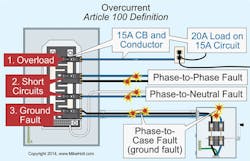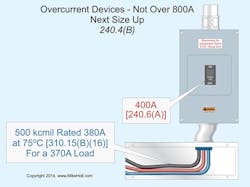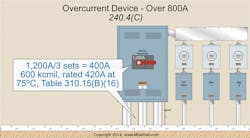Undersize your overcurrent protective device (OCPD), and normal operations might become impossible. Oversize your OCPD, and the whole place might burn down.
It helps that, for a given circuit, conductor sizing and OCPD sizing begin with the same two steps. Once you do them for the OCPD, you can reuse the results for the conductors.
It doesn’t matter which one you size first, but from a workflow standpoint, it’s usually better to size the OCPD first. The examples in Annex D of the NEC also show the workflow in this order. The shared initial steps put you one final step away from determining the correct OCPD size, but you will be many steps from determining the correct conductor size. Those two initial steps are:
1. Characterize the load.
2. Calculate the load
Load characterization
For OCPD sizing purposes, characterizing the load means determining which part(s) of it you’ll apply the 125% rule to. This rule generally means you multiply the continuous load by 125%. A continuous load is one that can be reasonably expected to run (at maximum current) for three hours or more (Art. 100). You multiply the load (in amperes) by 125% to account for the additional heat in conductors that aren’t allowed to cool.
Depending on your application, you must apply the 125% rule to some loads that fall under special rules (the rule(s) will be stated in the applicable Code section). As with the situation of running continuously, the issue again is heat dissipation (or lack thereof).
So that you don’t under-calculate the load, ensure you identify two things:
1. Which loads are continuous and which are noncontinuous.
2. Which loads fall under special rules.
Load calculations and OCPDs
Your project has continuous and noncontinuous loads, plus perhaps other loads that require application of the 125% rule. What do you do with these, next?
For all loads except motor loads, the “short version” of the process is this:
1. Add up the continuous loads and multiply by 125%.
2. Add up the noncontinuous loads.
3. Add up the two numbers you just calculated; this is your total load.
4. Select a standard size OCDP large enough to accommodate the total load.
If you calculate a total load of 265A, normally your OCPD will be rated at 300A. However, there may be a reason to choose an OCPD larger than what’s needed for the intended load. For example, you may need to allow for expansion. But the conductors must be able to handle the available current, so upsizing the OCPD means you must also upsize the conductors.
Motor OCPDs
Why do you need a different process for sizing motor OCPDs? In non-motor circuits, the OCPD handles two functions:
1. Overload protection
2. Overcurrent and fault protection
Motor circuits have high inrush current, typically five times the running current. If you size the OCPD large enough to permit motor starting, the OCPD is too large to protect against overcurrent from overload.
So for motors, the two functions are handled by two different devices. The OCPD protects the circuit from overcurrent (faults and shorts), while the motor overload (which may be a set of thermal metal strips in the motor controller) protects the motor from overload. Consequently, sizing motor OCPDs is a different procedure; you’ll find it detailed in Art. 430, Part V.
Overcurrent
The motor issue doesn’t make sense unless you understand the difference between overcurrent from overload and overcurrent from a fault or short. Overcurrent is a condition where the current exceeds the rating of equipment or ampacity of a conductor due to overload, short circuit, or ground fault [Art. 100] (Fig. 1). If you get a short circuit or ground fault, the increase in current is dramatic. In both motor circuits and non-motor circuits, the OCPD protects the circuit against this large increase in current.
But suppose you simply put too much load on a circuit. Consider a 20A office circuit. It’s running about 16A of load — then Joe plugs in his coffee maker. The overload causes the OCPD to trip. This increase, unlike that of a short or fault, wasn’t large. It just made the total current demand more than the circuit is rated to handle.
What if it’s a motor circuit? For example, a scrap grinder normally handles a feed rate of 60 pieces per minute. An operator decides to feed it 70. The motor draws more current to handle this. Now the operator keeps increasing the feed rate, and the motor keeps drawing more current — until it reaches an overload condition. In this case, the OCPD doesn’t respond. But the motor overload device does.
The motor overload primarily protects the motor. Obviously, the conductors are also protected. But it’s also true they’ve been sized to permit the higher current of motor starting. The overload, however, can’t protect the conductors from a fault or short; it simply can’t respond fast enough. The OCPD does that. An OCPD protects the circuit by opening when the current reaches a value that is too high for those conductors.
An OCPD must have an interrupting rating sufficient for the maximum possible fault current available on the line-side terminals of the equipment [Sec. 110.9]. Electrical equipment must have a short-circuit current rating that permits the OCPD to clear short circuits or ground faults without extensive damage to the circuit’s electrical components [Sec. 110.10 Note].
Protection
Article 240 provides the general requirements for overcurrent protection and the installation requirements of OCPDs. There are many different rules for protecting conductors and equipment. It’s not simply 12 AWG wire and a 20A breaker.
The general rule is that conductors must be protected at the point where they receive their supply [Sec. 240.21]. That protection is based on the conductor ampacity, as listed in Table 310.15(B)(16).
Except as permitted by Sec. 240.4(A) through (G), conductors must be protected against overcurrent (per their ampacity), after ampacity correction and adjustment required in Sec. 310.15.
Small conductors
Unless specifically permitted in Sec. 240.4(E) or (G), overcurrent protection must not exceed the following [Sec. 240.4(D)]:
1) 18 AWG copper, 7A
2) 16 AWG copper, 10A
3) 14 AWG copper, 15A
4) 12 AWG aluminum/copper-clad aluminum, 15A
5) 12 AWG copper, 20A
6) 10 AWG aluminum/copper-clad aluminum, 25A
7) 10 AWG copper, 30A
Specific equipment
Overcurrent protection for some equipment must comply with the requirements referenced in Table 240.4(G). When sizing and protecting conductors for equipment, be sure to apply the specific requirement(s).
800A or less
The OCPD sizing rules depend on whether an OCPD is rated over 800A. For OCPDs rated 800A or less, you can use the next higher standard rating of overcurrent device listed in Sec. 240.6(A) (above the ampacity of the ungrounded conductors being protected) [Sec. 240.4(B)].
But for you to do that, your circuit must meet these conditions:
1) The conductors aren’t part of a branch circuit supplying more than one receptacle for cord- and plug-connected loads.
2) The ampacity of a conductor, after applying ambient temperature correction [Sec. 310.15(B)(2)(a)], conductor bundling adjustment [Sec. 310.15(B)(3)(a)], or both, doesn’t correspond with the standard rating of a fuse or circuit breaker in Sec. 240.6(A).
Let’s work an example problem, assuming we’ve already decided on the conductor size and want to size the OCPD accordingly. What’s the maximum size OCPD you can use to protect 500kcmil conductors, where each conductor has an ampacity of 380A at 75°C, per Table 310.15(B)(16) and the calculated load is 370A? (Fig. 2)
As per the Table, the maximum size rating of the OCPD is 400A.
Over 800A
If the OCPD rating exceeds 800A, you can’t just use the next size up. You must ensure the conductor rating is at least that of the OCPD [Sec. 240.4(C)]. But the rating you’re working with starts with the conductor ampacity. To that, you apply ambient temperature correction [Sec. 310.15(B)(2)(a)], conductor bundling adjustment [Sec. 310.15(B)(3)(a)], or both.
An example problem helps illustrate how this works. In this case, we know the OCPD size and need to determine the minimum conductor size. What’s the minimum size of conductors for a circuit with a 1,200A OCPD using three sets of conductors per phase? (Fig. 3)
Conductor ampacity per raceway = 1,200A ÷ 3 = 400A
Conductor size = conductors per phase, rated 420A at 75°C [Table 310.15(B)(16)]
Total conductor ampacity = 420A × 3 conductors
Total conductor ampacity = 1,260A
Therefore, the minimum size conductor is 600kcmil.
Just a start
We briefly touched on the basics of conductor sizing. In our next two articles, we’ll dig deeper into the subject. Those articles will also reinforce what you’ve learned about OCPD sizing.
Holt is the owner of Mike Holt Enterprises, Inc. in Leesburg, Fla. He can be reached at www.mikeholt.com.







